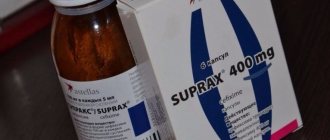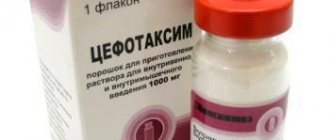Amoxil, the instructions for use, which emphasizes its antibacterial nature, is used to combat various types of bacteria. The drug contains penicillin, which is used to treat the consequences of infections entering the body, regardless of their location. The drug has a low level of toxicity and is also quite effective.
Description of the drug "Amoxil": composition, release form
They are produced in tablet form, packed in 10 pieces per blister. One pack contains 2 blisters. The round, white-yellow tablets contain amoxil (amoxicillin trihydrate) and clavulanic acid potassium salt. If the latter is present, there is a mark on the package - K625.
The denomination of one tablet is 500 mg or less (250 mg). Additional components that enhance the effect of the main antibiotic substances:
- povidone;
- sodium starch glycolate;
- calcium stearate.
In addition to tablets, you can purchase powder forms of medicine in pharmacies, which are used:
- for preparation of infusion (oral administration);
- for intravenous injections.
Analogs
The drug Amoxil has numerous analogues; they are produced by domestic and foreign pharmaceutical companies.
Tablets with a dosage of 250 or 500 mg contain the same amoxicillin, they have the following trade names:
- Amosin;
- Amoxicar;
- Danemox;
- Gonoform.
Amoxil, which contains clavulonic acid and a dosage of 625 mg, has the following analogues:
- Amoxiclav;
- Augmentin;
- Flemoklav Solutab;
- Panclave;
- Clavunat;
- Flemoxin Solutab.
Pharmacological properties
A semi-synthetic antibiotic affects the cell walls of bacteria, reducing their strength, which leads to the death of microorganisms. Clavulanic acid neutralizes enzymes that release harmful bacteria in response to the action of an antibiotic.
Pharmacological group
This drug is combined with a wide spectrum of action. Amoxicillin, a penicillin antibiotic, and clavulanic acid, a beta-lactamase inhibitor (bacterial enzyme), have a therapeutic effect.
Pharmacodynamics
The acid that is part of the medicine (antibiotic) forms compounds that prevent microbes from damaging the structure of amoxicillin, which increases its effectiveness. The antibiotic is active against many microorganisms. Its actions are bacteriostatic in nature.
Pharmacokinetics
Absorption of the drug is 100%. After taking the tablets (suspension), its concentration in the blood increases rapidly. The maximum is reached after an hour.
Bioavailability rating: 70%. Both substances are metabolized in the liver, excreted through the lungs, intestines, kidneys, 70 minutes - half-life.
Contraindications
Do not use Amoxil if you are allergic to amoxicillin or any other penicillin antibiotic, such as ampicillin (Omnipen, Principen), dicloxacillin (Dycill, Dynapen), oxacillin (Bactocill), penicillin (Beepen-VK, Ledercillin B. K., Pen-V, Pen-Vee K, Pfizerpen, V-Cillin K, Veetids), and others.
Before using this drug, tell your doctor if you are allergic to cephalosporins such as Ceclor, Ceftin, Duricef, Keflex and others, if you have a history of asthma, liver disease or kidney disease, bleeding or gastrointestinal upset, mononucleosis, or any type allergies.
Amoxil may reduce the effectiveness of birth control pills, which may lead to unwanted pregnancy. Before taking it, talk to your doctor about additional contraceptive measures if your primary contraceptive is hormonal pills.
Overdose and side effects
The use of Amoxil can provoke:
- allergic reactions;
- disorders of the digestive tract;
- development of superinfections resistant to penicillin antibiotics;
- with long-term use and high doses - nervous system disorders.
Overdose symptoms: diarrhea, nausea, vomiting, dehydration.
Help in case of overdose: gastric lavage, taking activated charcoal, restoring water and electrolyte balance, in severe cases - hemodialysis.
As indicated in the instructions for use, Amoxil 500, 250, k-625 should be stored out of the reach of children, at a temperature of 15º to 25º Celsius and away from light. And remember: antibiotics, like other medications, can only be prescribed by a doctor who has established a diagnosis and drawn up an individual treatment protocol for the patient.
Instructions for use and dosage
There is no need to tie the medication to breakfast, lunch, or dinner. You can take the tablets regardless of meals.
In the treatment of childhood diseases
The daily and single dose of Amoxil for children depends on age and weight, the duration of use depends on the severity of the disease and the type of pathogen.
| Age | Norm for a single dose, mg | Number of receptions | Daily value, mg |
| 1-3 years | 250 | 2 | 500 |
| 3-10 years | 250 | 3 | 750 |
| 10 years and older | 500 | 2 | 1000 |
If the disease is severe, the daily dose is calculated based on the child’s weight. The calculation is based on 60 mg per kilogram of body weight. Take the medicine in three doses.
Injections are used to treat children from 3 months. They do this in extreme cases when other treatment methods do not help:
- from 0 to 3 months, the baby is administered the medicine twice, keeping a gap of 12 hours between injections, the calculation takes the value of 25/5 mg/kg, a prerequisite is body weight > 4 kg;
- from 3 months to 12 years of age, the drug is administered every 8 hours.
Doctors prescribe the suspension to children from 9 months until they reach 12 years of age. In the age range from 9 months to 2 years, the child receives medicine 3 times a day, the daily norm is calculated based on weight, the formula: body weight in kilograms * 20 (40) mg. For older children (2-12 years old), the dosage regimen is the same (3 times a day), the daily dose is calculated based on a volume of 20-50 mg/kg.
For adults
ENT diseases, classified according to the nature of their course as mild or moderate, are treated according to the following scheme:
- reception 2 times a day;
- single dose from 500 to 700 mg.
Severe forms of inflammation require an increase in the daily dose to 3-6 g. It is not recommended to exceed the norm of 6 g.
The duration of the course depends on the type of bacteria; it can be 7-10 days . Injections are given only intravenously, an interval of 6-8 hours is observed. The permissible daily dose is 1000/200 mg.
In old age
The daily dose and treatment regimen are determined by the doctor. In patients over 60 years of age, the concentration of liver enzymes is checked during treatment with Amoxil.
During pregnancy and breastfeeding
Breastfeeding and taking Amoxil are not compatible, the reason is the presence of amoxicillin in milk. The concentration is small, but there are risks, so the mother of the baby is transferred to artificial feeding for the entire duration of treatment.
During testing of the drug, no negative effect on the development of the embryo was revealed. However , antibiotics are prescribed in extreme cases if the mother's condition is of concern. It is taken especially carefully in the first trimester.
People with impaired renal function, liver function and diabetes mellitus
For kidney problems, glomerular filtration rates are monitored; if its rate is 10-30 ml/min, then 250 (500) mg are prescribed at intervals of 12 hours. At speed
In people with liver pathologies, Amoxil can provoke liver failure; treatment requires strict monitoring.
Amoxil price, where to buy
In Ukraine, Amoxil is sold at an average price of 19 UAH. for 20 tablets of 250 mg. The price of Amoxil in a dose of 500 mg ranges from 29 to 34 UAH.
- Online pharmacies in RussiaRussia
- Online pharmacies in UkraineUkraine
LuxPharma* special offer
- Amoxil tablet
No. 20 500 mg 1600 rub. order
show more
Pharmacy24
- Amoxil-K 1000 875 mg/125 mg No. 14 tablets PAT "Kievmedpreparat", Ukraine
94 UAH.order - Amoxil-KMP 250 mg No. 20 tablets PAT "Kievmedpreparat", Ukraine
41 UAH order
- Amoxil-KMP 500 mg No. 20 tablets PAT "Kievmedpreparat", Ukraine
57 UAH order
- Amoxil-K 1.2 g No. 1 powder PAT "Kievmedpreparat", Ukraine
38 UAH order
- Amoxil DT 500 mg No. 20 tablets PAT "Kievmedpreparat", Ukraine
57 UAH order
Side effects
Taking any antibiotic can be accompanied by various side effects. Each patient has individual manifestations.
Gastrointestinal tract
The digestive system reacts with stool upset, attacks of nausea, and vomiting. In rare cases, superinfection occurs. While taking Amoxil, the patient may experience increased dryness of the oral mucosa, decreased appetite, increased flatulence, and attacks of colitis are possible.
Blood-forming organs
During therapy, it is necessary to monitor the condition of the liver. Cases of jaundice and hepatitis were recorded. The hematopoietic organs can react:
- anemia;
- eosinophilia;
- reversible leukopenia.
During treatment, the patient's PTT parameter may increase and its derivative PTI (prothrombin time, prothrombin index) may change; blood clotting is assessed using them.
central nervous system
There are statistics on reactions from the central nervous system. Disturbances in its functioning when taking an antibiotic are manifested by a state of depression, neuropathy, and ataxia. A person may experience dizziness, headaches, convulsions, and possible fainting. The patient may experience sleep disturbance and increased anxiety. urinary system
Interstitial nephritis is a possible reaction of the urinary system to taking the drug Amoxil.
Allergy
The list of possible allergic reactions is wide. It consists of typical manifestations characteristic of people prone to allergies:
- hives;
- itching;
- redness of the skin;
- swelling;
- anaphylactic shock.
In addition, taking an antibiotic can cause fever, cause eczema, dermatitis, hyperkeratosis, vasculitis, serum sickness, and epidermal necrolysis.
special instructions
The possibility of developing an allergy to cephalosporin and penicillin antibiotics should be excluded before starting treatment.
Repeated and long-term use leads to the development of resistance and superinfections.
Vomiting and diarrhea reduce the absorption of the drug; in these conditions it should not be prescribed.
Prescribed with caution to patients with asthma and allergic diathesis .
Taking the drug in high doses causes the development of crystalluria , so for prevention it is necessary to take a sufficient amount of fluid.
The drug can change the color of tooth enamel in children, so you need to ensure proper dental and oral hygiene.
In case of anaphylactic shock, artificial ventilation of the lungs is performed, epinephrine , antihistamines , glucocorticoids and oxygen .
Drug compatibility
Before starting antibiotic treatment, you need to find out about drug compatibility. This applies to those patients who use other types of medications. For example, when taking Amoxil and a contraceptive simultaneously, the effect of the latter is reduced and there is a risk of bleeding.
A number of medications slow down the elimination of antibiotics by the kidneys:
- "Sulfinpyrazone";
- acetylsalicylic acid;
- "Phenylbutazone";
- "Probenecid";
- "Indomethacin";
- "Oxyphenbutazone."
The quality of the bactericidal action of Amoxil is influenced by antibiotics belonging to the groups of tetracyclines, macrolides and the drug Chloramphenicol.
Reviews about Amoxil
By studying reviews about Amoxil, you can be sure that it is a fairly affordable and effective drug. There are a lot of good opinions about its use for bronchitis , pneumonia and tonsillitis , both in adults and children. Patients who used the drug noted rapid recovery.
There are also several positive reviews of use for streptoderma and other pustular skin lesions.
The disadvantage is that some patients experience side effects such as skin rashes or gastrointestinal upset.
Another advantage is that, due to its safety, Amoxil tablets are allowed to be used by pregnant and lactating women.










